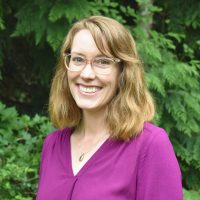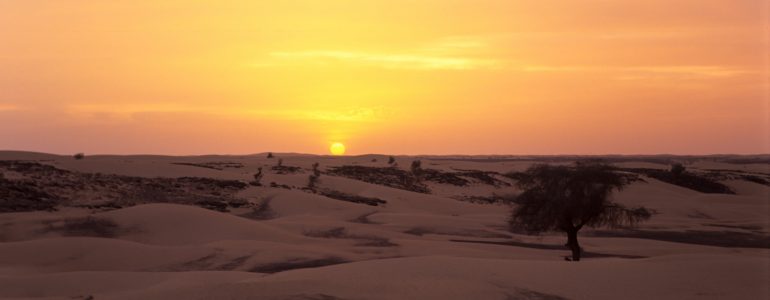Life, In Spite of It All: Water, Wetlands, and Reclamation in a Changing Climate
November 2024 Update
Overview:
This project centers the voices and experiences of the Haalpulaar’en community of Khareirat in southern Mauritania and their relationship with Tambass, a 4,400-acre wetlands area. Mauritania, historically hot and arid, now faces extreme weather fluctuations between droughts and violent rainstorms. Although there are few wetlands in the country, they are crucial for flood control and water storage buffers in an increasingly unpredictable climate. However, human actors have drained Tambass, a critical water source for the Khareirat herders, their animals, migratory birds, and other life forms. This has left the community’s primary water source unreliable, exacerbating the impacts of climate change. Without some type of intervention, Tambass will disappear, threatening the social-ecological cultures it supports.
Approach:
This interdisciplinary project, co-designed with local partners and the Khareirat community, includes creating a documentary film, developing a qualitative and quantitative wetlands map, and conducting historical analysis of drying events. The project aims to embody the mutually enriching potential of actionable humanities and science as forms of reclamation and repair.
Key Components:
- Documentary Film: Titled “Tambass: Life, In Spite of It All,” this film will center on the community’s attempts to live with major hydrologic changes and discover possibilities of action and repair. Developed in partnership with the community and Oscar-nominated filmmakers Aberrahmane Sissako and Kessen Tall, it will include interviews with community members and artists responding to the global climate crisis and the wetland’s draining. The film adopts an ethnographic approach, emphasizing the knowledge and wisdom of those affected.
- Wetlands Mapping: Community stories, art, and emotions will be combined with scientific data on the land and waterscape. Partnering with Digital Earth Africa, the project will develop a humanities “supplement” to their waterbodies data dashboard app, integrating community-generated content such as cell phone videos, text, and visual art.
- Restoration Plan: Scientific analysis and capacity building will identify potential restoration scenarios. Historical analysis of water dynamics will inform how restoration might proceed, supporting informed conversations with decision-makers and providing evidence-based support for restoration feasibility.
Activities:
- Return Visit to Mauritania: The project team will co-design aims and itinerary with all partners. Focus will be on developing deliverables with the community, identifying critical data, clarifying access needs, and connecting with regional partners.
- Film Production: The team will continue recording interviews and community activities, emphasizing community knowledge and experiences.
- Wetlands Mapping Development: The project will collect and integrate community-generated content with scientific data, creating a new mode of community voice and engagement.
- Restoration Planning Workshop: A workshop will be organized with community members, regional partners, and university students to develop data, tools, and networks supporting the restoration plan.
Expected Outcomes:
- Increased Awareness and Advocacy: The documentary film and wetlands map will bring broad awareness to the hydrologic situation of Tambass and create pressure at the national level.
- Enhanced Community Engagement: The waterbodies app will allow community members to monitor water management and engage in ongoing water monitoring.
- Informed Restoration Efforts: Historical analysis and scientific support will provide a platform for informed conversations with decision-makers, supporting the feasibility of restoration.
Dissemination of Findings:
All products will be translated into Pulaar, Hassaniya, French, and English, and disseminated through various channels, continuing to evolve partnerships and support the community’s ongoing needs.
Research Team:
Principal Investigator: Richard Watts, Associate Professor, UW Seattle College of Arts & Sciences, French and Italian Studies
Community Leads:
Abderrahmane Sissako, Co-director of AME, Filmmaker, Association Mauritanienne pour l’Environnement (AME)
Kessen Tall, Co-Director of AME, screenwriter, Association Mauritanienne pour l’Environnement (AME)
UW Co-Investigator: Daniel Hoffman, Professor, UW Seattle College of Arts & Sciences, Jackson School of International Studies
UW Student: TBD. Graduate student.
Collaborators:
Meghan Halabisky, Academic Collaborator, remote-sensing ecologist, UW College of the Environment/Digital Earth Africa, UW Seattle College of the Environment, School of Environmental and Forest Sciences
Maureen Ryan, Academic Collaborator, Owner and principal, Dark Creature LLC
Lisa Rebelo, Academic Collaborator, interpreter, affiliated with Digital Earth Africa
Abou Sow, Community Collaborator, interpreter, affiliated with Association mauritanienne pour l’environnement
Sidi Cheiguer, Community Collaborator, interpreter, freelance filmmaker, affiliated with Association mauritanienne pour l’environnement
Amadou Sall, Academic Collaborator, Wetland Lead for West Africa, Centre de suivi écologique Dakar, Senegal
EarthLab Contact:

